Informal formality

Before the collapse of the Soviet Union, both their political and economic systems started to crack. Almost everyone in the nation knew the society was falling apart, but they had to pretend it was normal because no one could envision any alternative system other than communism since the free information from the western world was blocked off by the government. This phenomenon was described as “Hypernormalisation” in Alexei Yurchak’s book Everything Was Forever, Until It Was No More: The Last Soviet Generation, “You are so much a part of the system that it was impossible to see beyond it.”
This accurately describes the urban environment we live in nowadays in terms of urban planning and urban design. There are thousands of cities in the world that more than 60% of the global population lives in, however, only a handful of them are considered truly great cities. Since the globalization of economy and culture, many cities share the same cityscapes and skylines of modern high-rises and massive traffic spaces, especially the cities developed recently. People living in these cities are constantly suffering from problems such as overcrowding spaces, skyrocketing housing prices, air/water pollution, large carbon emission, cramped public spaces, terrible traffic, as well as lack of visual identity and regionalism. The worst of it is that even though there are so many obvious problems in these cities, people choose to compromise and accept them as a part of urban lifestyle. Gradually, the abnormal becomes normal, and everyone is trapped in this problematic urban typology.
For example, the city of Beijing and San Paulo look almost identical from both the street side and from above. Their cityscapes are largely influenced by the internationalism and economic exploitation; therefore, much of the integrity and culture of the city is lost. The illusion of economic growth and propagandized media coverage only show the positive aspects that happened during the urban development. Before they realize it, the city in their memories has long gone, replaced with concrete columns and glass glazing.
In these developing countries, the real estate market is rapidly increasing with a fast growing economy, which gives developers much more power to control the market. This imbalance of economic power causes terrifying consequences: single family housing sometimes costs a lifetime of savings, but the architectural quality is only worth a fraction of it. As a result, urban real estate properties have become more of investments for wealthy than homes to the urban population. This distortion of economic stability has often resulted in unbelievably high housing prices, vacant developments, massive ghost towns, and even real estate bubbles.
Although there are serious problems with urbanization, it is unwise to abandon the urban development plan as a whole. It is far more sustainable to have the majority of the population live in cities, plus it is an easy solution to the growing population issue. In last few decades, history has proven that decentralized population and resources have huge environmental impacts and largely reduces the efficiency of all infrastructures. Vast landscape and spread out settlements create enormous possibilities for systematic waste. Despite material waste for building the infrastructure reaching that far, it is a fact that one water pipe leak just the size of a dime will waste nearly 6,300 gallons of water a month. In addition, about 14-18% of water treated in the United States is wasted through aging and damaged infrastructure, as well as faulty meters. According to the global trends, as well as many other obvious facts, the urban lifestyle will continue to dominate the planet in the future.
To maintain the position of urbanization, many authorities such as urban planners and politicians have been trying to solve these problems, but their minds are too trapped in the system, and more importantly, some of them often benefit from this crooked system. What they have done to try to solve these everlasting problems is using methods that only scratches the surface: they start to plan projects that seem right like adding parks to residential area, replacing old buildings with new ones, or constructing iconic buildings in a city center. Even though some of these solutions are effective, much of their goal behind them was to increase the attractiveness of the area and the real estate price for developers and global investors. They seem to pay more attention to the public image created by renderings and statistics generated by computers than what these projects’ real effect on people’s lives. Eventually, some cities with fast growing economy turned into the mess as we see them today. It is much like the story of Frankenstein: by adding all the parts that make sense and are attractive together, in theory we should have an ideal result. However, in the end, nothing more than a monster of city is created.
Citizens see these horrifying problems with their own eyes, and sometimes complain about it, but they have absolutely no control over it. The disastrous urban environment is gradually reshaping people’s way of living. They would continue their days by moving from one building to another by driving through terrible traffic, then coming back the same way. They would continue to live in their condos with a window looking out to millions of other homes looking just like the ones they have. They would continue paying mortgages for home whose value is mostly a giant bubble. They would continue hanging out with their online friend inside without knowing any of their neighbors. They would…
Sometime you may wonder: how did we get to this point that everyone is stuck in the same problematic urban typology? Is there really no alternative other than accepting it?
What if there is a complete rebellion from the very bottom of this fragile system?
Living in the age of the internet, no one asks the fundamental questions like “where does the internet exist” or “what is open source code” anymore. The concept of free sharing and open source information is not strange to the public. It is very interesting that the terms open source code or open source software were not popular terms 20 years ago. Before 1990, the software world was dominated by giants like IBM and Microsoft. These companies kept their source codes very secretive because they were extremely concerned about people copying or cracking their systems. At the time, only a few pieces of software published by these companies, mostly business software, were able to run on home computers, which very much limited the power of them.
In 1991, a freely modifiable source code called “Linux Kernel” was developed by Linus Torvalds. It was published and later used internationally, which broke the limit set up by traditional software packages that forbid anyone except for the publishers to modify or distribute the software. This breakthrough on open source codes made people realize the power of computers; the idea of open source laid the foundation of the information technologies that we have now. The concept of open source, unexpectedly, did not ruin the business of these large corporations, but instead stimulated their sales since computer products became much more desirable than they were before.
The real estate market and the information technology market are extremely alike from a macro perspective. The real estate giants are the rule makers of the game, and they do not want anyone to threaten their profit margin. Similarly, early large software superpowers were trying to protect their profit margin this way. However, the real estate business requires more capital and it is more of a necessity in most cultures.
The history always repeats itself. Again, this new ideology of open source urbanism would be terrifying to the large developers and politicians because it is unknown: they cannot predict how much profit could be extracted from the new system, and how stable the system is, that they could lose their control over the market.
Open source urbanism could gradually break down the limitation, such as corporate trusts’ bureaucracy and zoning complication, in the economic system set by these large corporations, and liberate the urban animals who are trapped in the problematic urban system for too long. This new system shares many similarities with the concept of the open source aspect of the internet: free remix and redistribution, access to the source, a higher degree of cooperation, and the end to predatory vender lock-in. This new system could transform urban spaces and lifestyles by using modular building components to form larger societal hub. The design and structure of each separate module was actually quite simple, but when they were grouped in a high density algorithmic pattern, they formed a new, highly rational urban system well-suited to the complexities of modern individuals and societies. The module design possesses amazing customizability and is able to adapt to multiple urban environments, geographic cultures, individual lifestyles, and technological advancements. Its adoption will lead to new discoveries that will help us solve existing problems and influence future trends in architecture. With infinite possibilities, open source urbanism could be the revival of new individualism, as well as a new infrastructure system for further development.
Georg W. Hegel once said: “Whatever is reasonable is true, and whatever is true is reasonable.” One thing Kowloon Walled City taught us is that a highly informal community could be extremely disciplined and rational. In that case, if there needs to be a convenient shop at 5th floor of building 12, there would be one, or the resident living in the unit would become one; if there does not need to be a restaurant, even if there is one opening up, it will not last long. Informal urbanism without macro control does not mean completely anarchy and chaos because there will always be relatively more efficient micro management.
Finally, as the alternative to the broken system, a highly efficient new urban typology would be formed, although it is systematically informal, where it remains highly rational.

Modules
To respond to the concept of open source urbanism, there must be a carrier for the ideas to be rooted. A pre-fabricate based modular system integrated with basic infrastructure that functions as both architectural structural elements and three dimensional perimeter set for different uses could not be more perfect. The modules establish order in the city fabric, and it is an effective way of acknowledging people the concept of zoning and space. Owners are able to build different programs within the perimeter and its structural load limit. The open source concept of Modular system will allow individuals take more control of their idea of ideal city rather than being under control of large developers, thus the urban areas will continue to grow healthily.
The standard size of each module is 20’x20’, which would fit in most of the affordable homes. Owners could purchase more of these as a part of their property. Larger developments are allowed to build their own modules of buildings fitting in the same grid. This allows verticality and movement in vertical dimension in terms of public spaces.
Made of high strength aluminum alloy, the structure tubing could be minimized down to just a thin layer of metal tubing. In the hollow tubing, utilities like water and electricity could run though to provide basic functionality for the module system. The horizontal waffle structure is able to take relatively heavy load without deforming, which enables many possibilities for various programs.
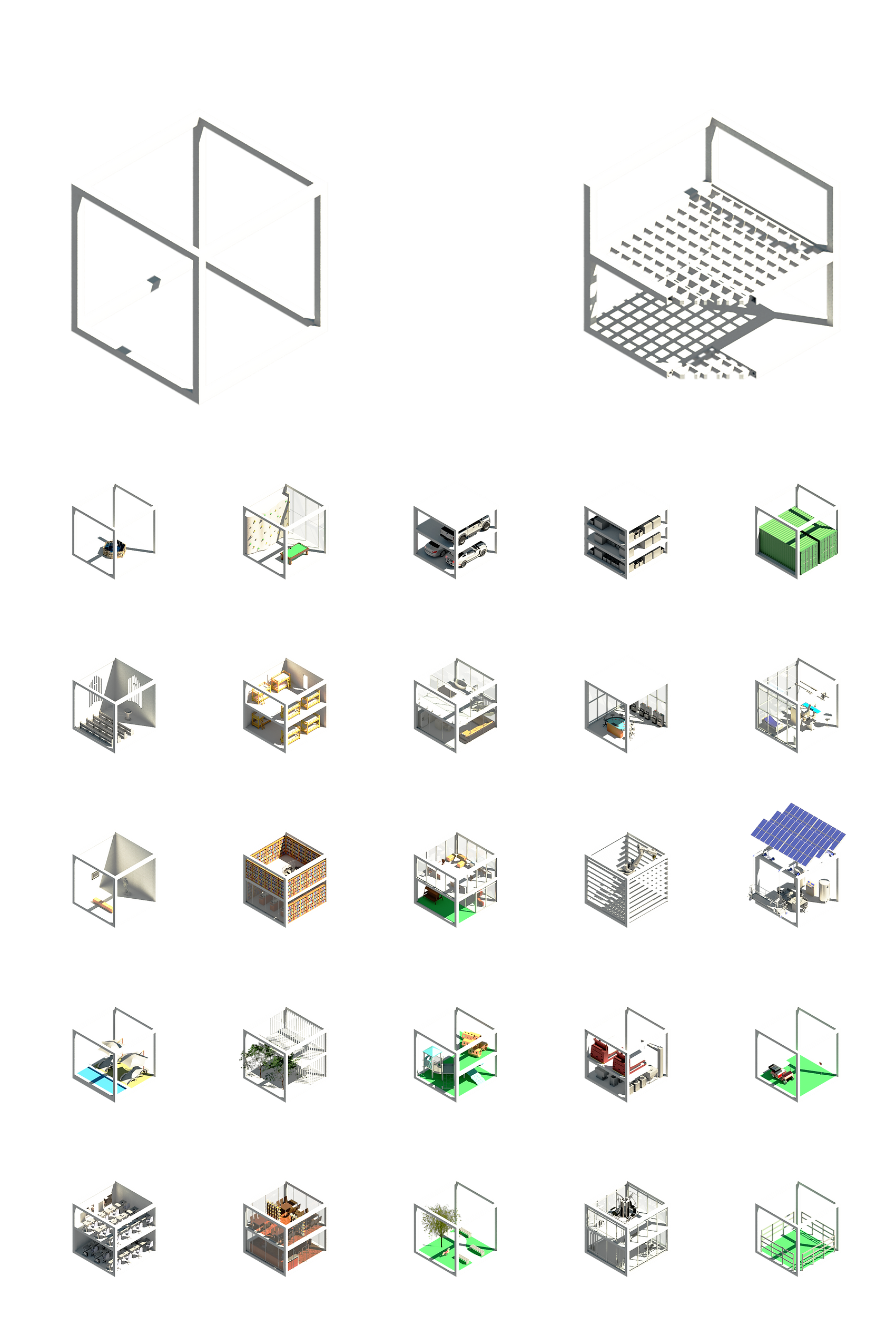
Programs
Various programs could be built within the perimeter of the module using the assistance of the structure provided by the module. Large programs could fit in the perimeter set by multiple continuous modules. Different program co-response to each others as a urban network.


Urban Typology
Traditional urban typology traps people indoors: a report pointed out that average Americans spend 90% of time indoors. Some designers think this could be an opportunity to promote better indoor environment since so much time is spent there. On the contrary, the reason why people spend so much time indoors is the outdoor space is not ideal, sometimes disastrous. With the liberation of ground level, many layers could be gradually added on top of each other’s and create more outdoor space and indoor space. Constructing more and better designed outdoor space could draw people out from their offices and homes, and giving the urban space more livelihood. The self-growing communities would form a new urban typology that drastically differs from any traditional urban typology. The city texture is not designed by any planner or designer, instead, it is the expression of millions individuals, and it is constantly changing. The new urban typology would increase the outdoor space, the land use efficiency, and the sense identity of both the city and individuals.
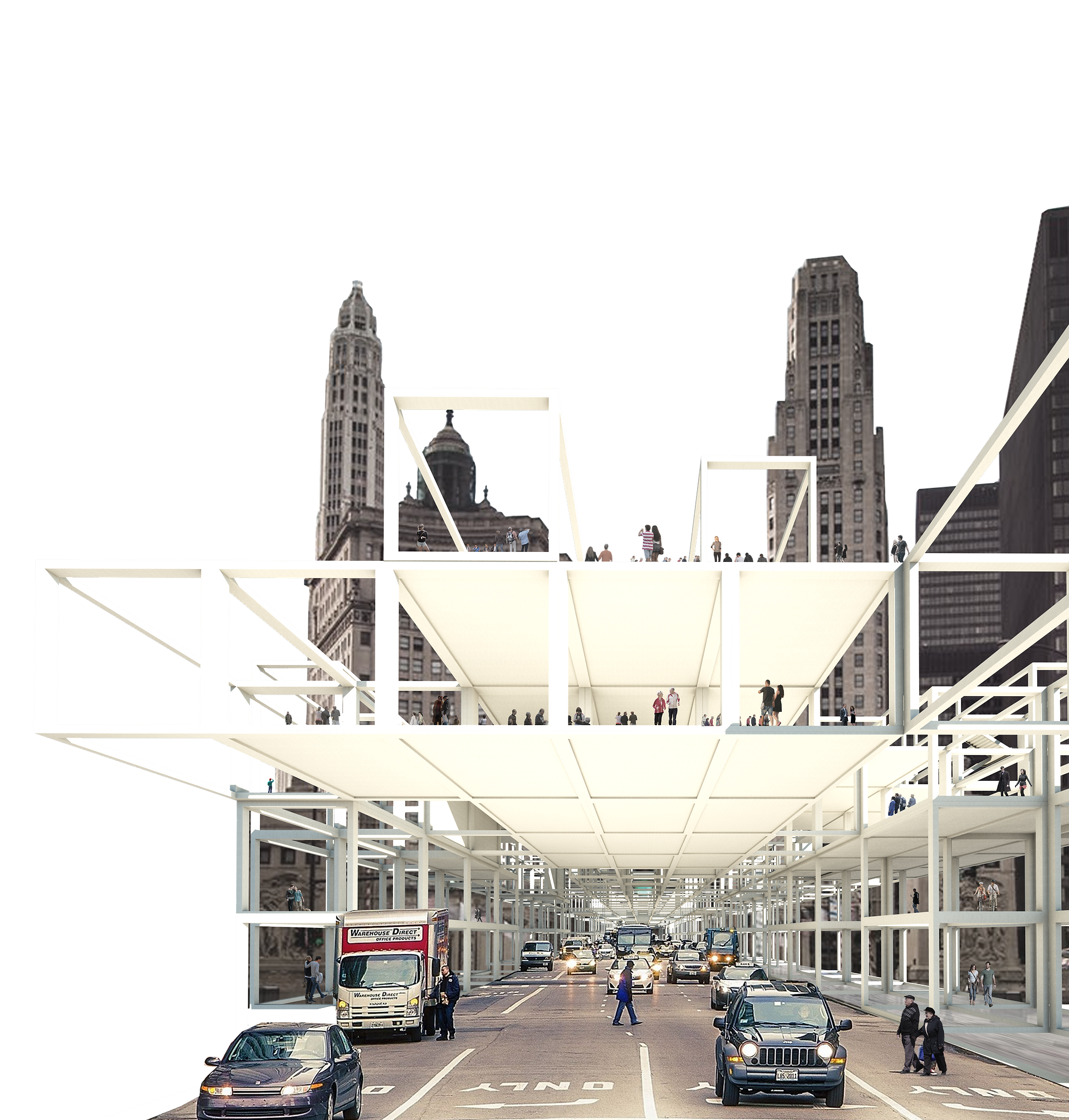
Transportation
It is not hard to find out that cities nowadays are mainly designed for automobile since it largely increased efficiency of urban activities. A large drawback from this mindset is that the more people use cars, the more often traffic jam appears. Luckily, recent technology could help people gross this paradox. Autonomous automobile allows the total separation between traffic and pedestrian. Since self-driving cars operates on sensors, there will be no sufficient natural light or traffic signal needed. With high level of efficiency, the ground level could entirely become a massive transportation system.
Layers
Traditional cities has only one or two layers of public space for activities, and a large part of each layer used by transportation. Multi-layered cities would be able to increase the public spaces and gain more access to all the buildings. Similar to the skywalk system in Hong Kong, separating traffic and pedestrian could increase the efficiency as well.
New Horizon
The new layers of cities creates enormous amount of public space away from the ground, these spaces are interconnected by different programs such as running trails, bike lanes, parks, gardens, and even shops. These spaces then connects to the dead spaces like roofs of buildings, creating many new horizons in the urban fabric, making the cities truly multi-layered urban areas.
Structure
With the modules being the structure of the system, constructing a community is similar to building a Lego model: simply stacking the modules on top of others and connect the power and water systems with standardized hook-ups. Similar to the Lego models, the more the single modular units are, the more stable the system is. The lateral load resistance is often transferred to the adjacent buildings.
Spaces
Although the spaces created by individual modules are highly informal, there is still micromanagement within the community. Owners of these modules have the absolute power to veto the development happing directly connecting the modules unless it’s pre-existing; and they have right to vote what could happen in their community, as well as the power to bring investment or development. The modules provide the perfect flexibility for the constant changing programs and use of spaces.

Basic Systems
The modules have built in space for the basic life supporting systems like water, power, and sewage system to run through. The simple hook-ups allows residence to use these systems in their own modules, however, connecting to these hook-ups require to install a electric sensor for monitoring the usage. These basic systems are connected to the central distribution system underneath each geographic section. Roof top gardens are able to collect rain water and clean it using built-in bio-filters; and roof top solar power stations have the ability to capture the solar energy and store it in the power storage. Sometimes when there is a root top garden or a solar power station nearby, cheaper filtered water or electricity could apply to the module in order to encourage renewable resources.

Individualism
Since the modules are the private properties of each individual, and they would take advantage to display themselves. Similar to the Olympic students housing in Munich, where students could take advantage of the large surface of facade on their individual student housing unit to display their thoughts on politics, interests, and personalities. The module gives people even more freedom on ways of expressing themselves. The modules somehow can be treated as the platforms conveying their manifestation of avant-garde.

Regionalism
The critical regionalism and world culture are not paradoxical, on the contrary, they both are a part of human civilization. Modern technologies can be used as a expression of regional culture. The most important element in regional or traditional culture is human, and it is the very basic element of cities. Many modern cities took away the traditional cultures by settling people in homes and offices isolated from the public, which resulted in the lack of acknowledging these parts of culture brought by past generations. In this case, the modules are vessels containing the cultures, as well as the windows displaying them.

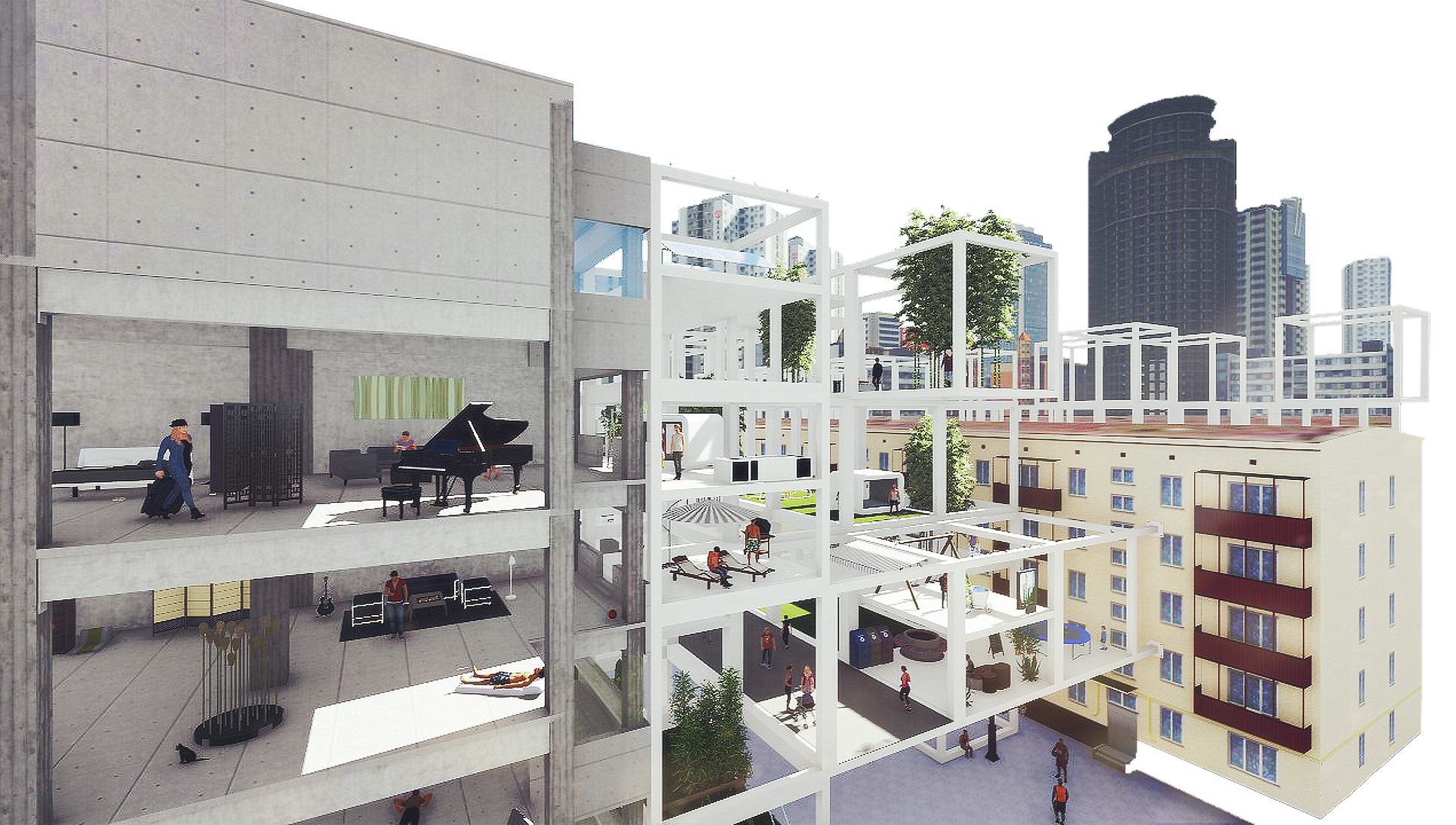
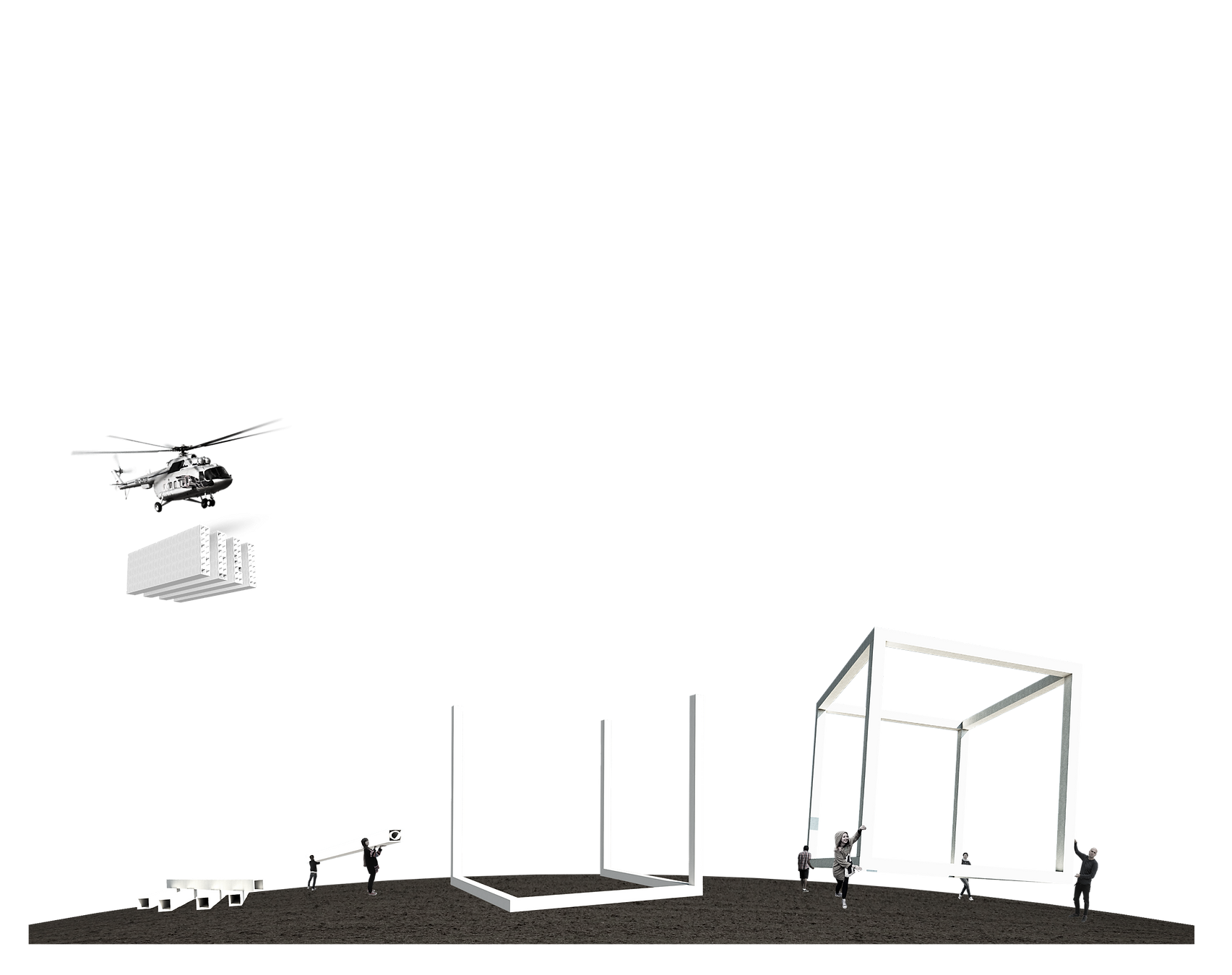
City Texture
City texture is the combination of countless tectonic forms and their facade. Traditionally speaking, the regulation of city development are mostly two dimensional, which give architects endless opportunities to design and build iconic structures. By dividing the city texture into smaller chunks and restricting the vertical dimension as well as the horizontal ones, the city texture would be more diversified vertically. On one hand, the city looks more unified as a whole standing from far away. On the other hand, there are more layers of detail in terms of what to see and experience at pedestrian level.
Portability
One big advantage of using ultra light weight aluminum alloy structural tubing as a modular building material is that anyone could pick it up and start to assembly the whole module by setting up the proper corner joint. With simple installation of corner joints, the modules can be put together even by very little educated people. This largely increases the portability and appliance of modules. The internet of things had connected the world together very thoroughly, largely increasing the efficiency of pre-fabrication and shipping industry. This largely increases the portability and appliance of the modular.
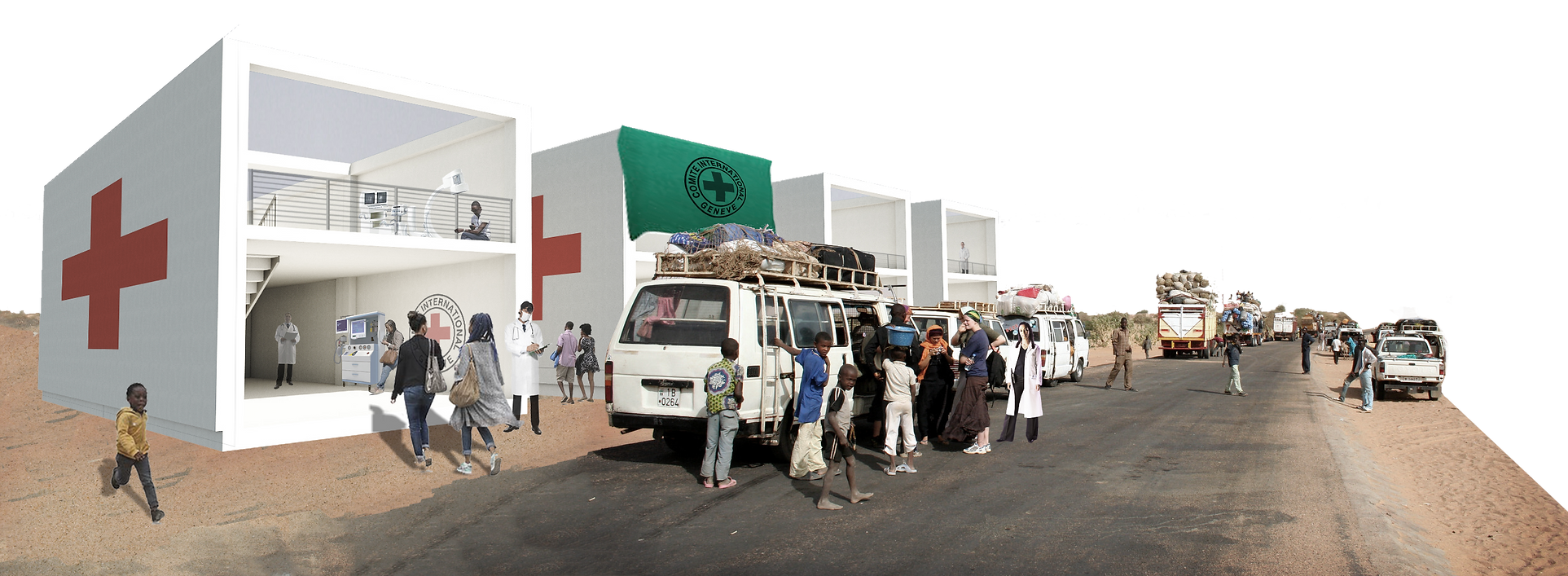
Global Appliance
The internet of thing had connected the world together very thoroughly, making the efficiency of pre-fabrication to shipping industry increased largely. As a strong and lightweight skeleton structure, the module could be shipped all over the world with very little damage. Since these parts are pre-fabricated, they would have the same high standard in manufacturing process, which means there would be no need for worrying about the qualities of building structure or pollution in terms of local factories. With simple installation of corner joints, the modules can be put together even by very little educated people. In this case, it is hard not to consider the modules as either building material or infrastructure for global appliance.
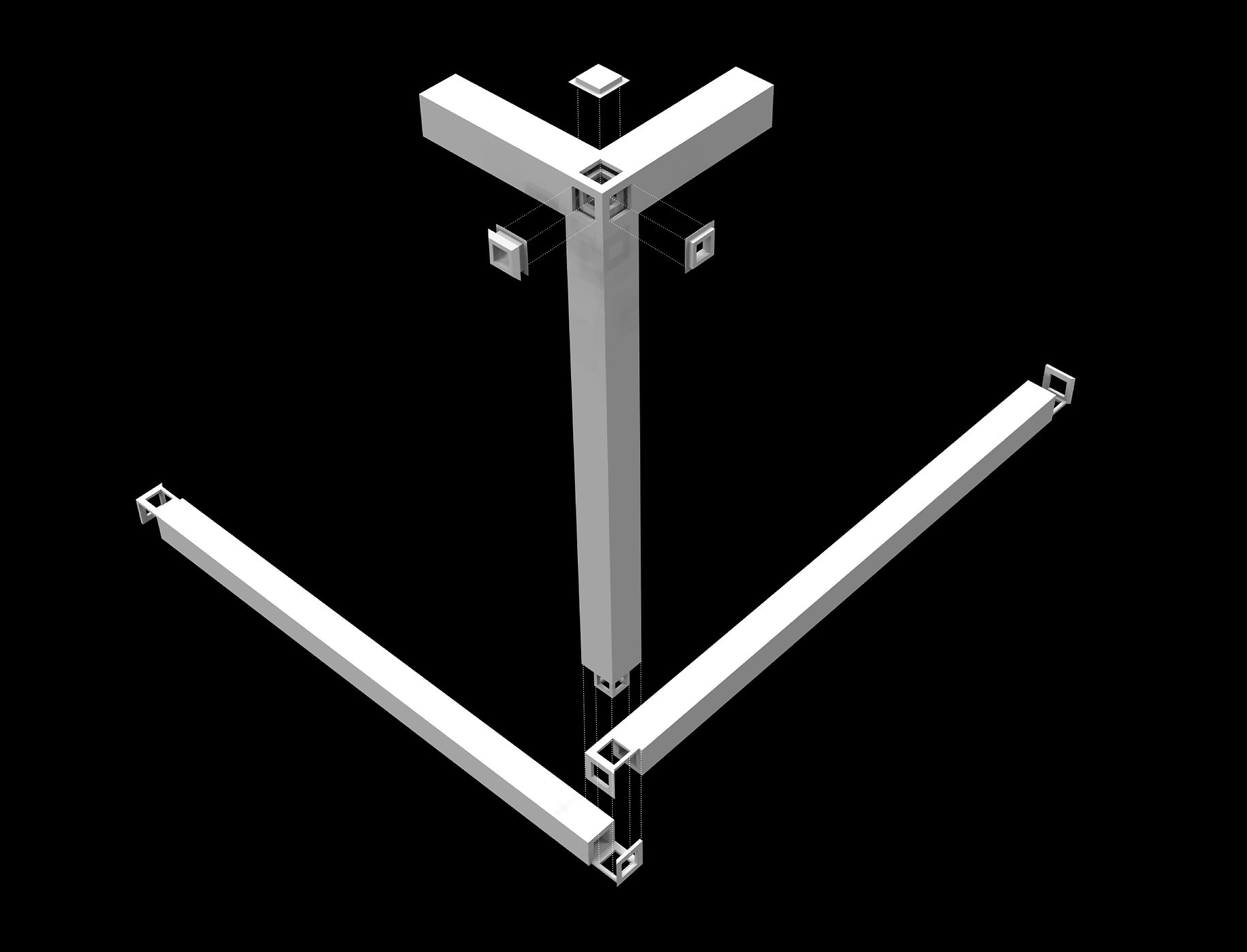
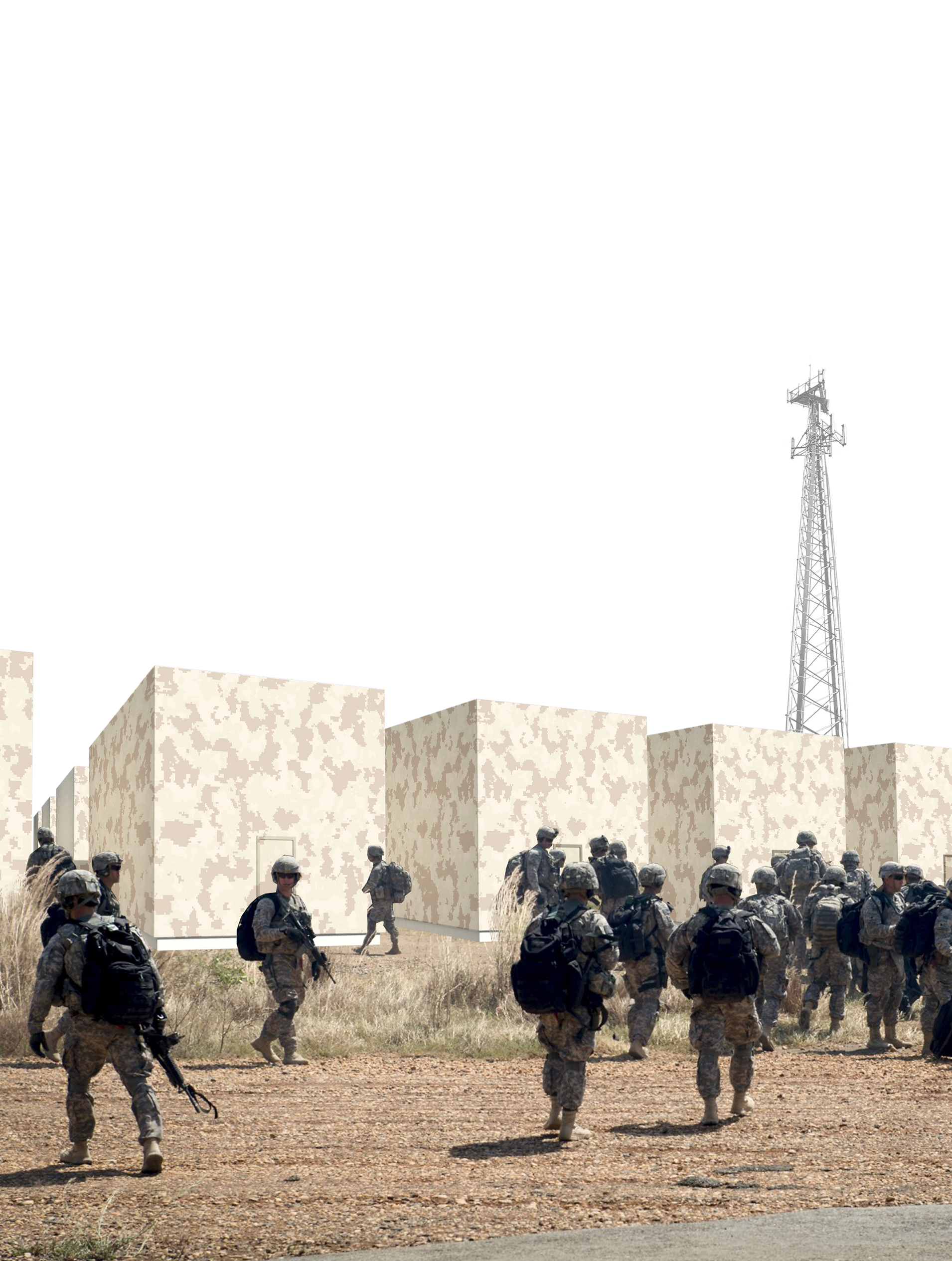
Social Justice
Not only could the module be a part of the city fabric, it is also capable of serving as humanitarian equipment. For many under-developed countries that do not have basic living infrastructure, these modules would provide them a stable platform to develop their urban system. As basic urban structure, the replacement of simple sheds made of garbage and waste building material, people are able to infill different functionality into it based on their lifestyles and economic capability, giving them a better and healthier standard of life. More than just housing units, these modules are able to provide structure for public transportation to link different cities and villages together as a whole urban system. The skeleton of each module gives them flexibility to fulfill many necessities, their duty could range from health center to military base.



Sustainability
As for sustainability, the informal community would be considered “green”. There are so many existing “green buildings” in the world, and yes they do have very limited negative impact on global environment. However, even though the green buildings themselves might do not consume as much energy as other old buildings, the carbon footprint on transportation, construction is still very significant. Also, without constructing the building, the land of which sits on could potentially be a piece of forest that absorbs greenhouse emission. On the contrary, even living and working in a less green building in densely populated area would possibly be more environmentally friendly. With convenient public transportation and walkable city streets, the carbon footprint per person could be greatly reduced in a very large scale. Increasing the density of urban space is equivalent to increasing efficiency of energy. Instead of expanding the cities horizontally, the cities could grow vertically to eliminate the impact on land and deforestation. The less land humans take over by constructing parking lots and short buildings, the more land could be used as real green vegetation. Plus, ever growing number of electric cars and environmental friendly urban landscapes would really enhance the sustainability of architecture. In another words, it means that, in terms of sustainability point of view, the location of the buildings may be more important than the green technology itself. True sustainable building is the result of reducing every single element that has carbon footprint. The new intervention of informal urbanism with its own structural support would allow cities growing vertically without too much central planning and over-complicated process from the state’s governance. To attract people to live in the cities, private owned partnership will apply to the new construction and ownership to the new urban system. Also the real-estate market will be more affordable due to the new influx of massive amount of urban space for housing, office, and public uses.
Even though living in cities are much more sustainable, the current city models are based on extremely high consumption of fossil fuel, which directly leads to the ongoing climate change:
Firstly, the main source of electricity in most countries comes from conventional coal/gas burning power plants which are extremely inefficient in terms of energy transfer, and create massive amount of greenhouse emission and air pollution. Luckily, the climate change has been recognized by public, many countries have started to shift its power grid to more sustainable sources, and solar panels stated to appear on single family house roofs in order to generate power for residential daily use as well. With similar concept, new informal communities in the cities will be able to serve large amount of power by using solar panel on top of existing buildings and new structures. The solar panels will be installed by power companies, and the owner of each rooftop will be paid by a portion of electricity production each month. The electricity will go into the local power grid and provide a significant amount of city’s daily electricity usage. The power generated will be a part of their electricity bill collected by power companies; and then a part of it will go back to those who provided rooftop space for solar panels. With rough calculating, a 20’x20’ roof will be able to generate 7200 kWh per month using PV panels with 30% efficiency, which serves about 8 families completely off-grid with average electricity usage. Along with the advancement of technology, the number will only go up. Plus, having people to accept this idea is less challenging nowadays, thanks to successful companies such as Airbnb, WeWork, and Uber, that the concept of sharing economy has being practiced and accepted by large amount of populations in recent years.
Secondly, modern urban lifestyle relies so much on automobile that consumes fossil fuel and emits greenhouse gas. With new structure built in between buildings, many layers of traffic will be created. This new traffic system rejects traditional cars running in its lane since the space for traffic is enclosed within the structure without large ventilation for large amount of exhaust gas. The enclosure protects pedestrian, and makes sure that people are completely separated from the traffic. Also, it increase the efficiency of autonomous traffic by eliminating uncertain human influence and increase average speed. The traffic “tunnel” is divided into four sections, two for each direction. The sections on the exterior are drop-off lanes that have openings for people to enter and exit the cars, meanwhile the center sections are lanes for fast traffic. Cars just took off will have to accelerate in the far part of drop-off zone to reach the synced speed in center lanes to join the fast traffic. All the cars in this new urban traffic fabric will be autonomous automobiles linked together under the one network so they will interact with other cars in the network calculated by algorithms after processing collected big data from the system. Most of these cars running on the streets are shared rides driven by artificial intelligence, thus people would not have to buy private cars to feel like first-class citizens. Also, this means the entire traffic system is running efficiently by computer, even though there is no traffic light, traffic jam will almost never happen. Because of the exclusiveness of conventional automobile in the cities and extremely high taxes on motor engine cars in the near future, petro powered cars will become toys for the rich living in the suburbs considered as classic cars.
Thirdly, efficient connections between cities in the world are often run by airplanes that has great environmental impact. There are over one hundred thousand fights are scheduled every day consuming 5% of fossil product, and emitting about 3% of world’s greenhouse gas goes directly into ozone. On the other hand, this shocking fact incubated the new generation of long distance transportation - Hyperloop. The Hyperloop operating tunnels will be able to be imbedded in the city fabric with newly constructed modular structure system blending in with the city traffic. The new pre-fabricated modules also provide low cost and fast constructing structure and infrastructure for Hyperloop tunnels outside of the cities.
Finally, many developing industrial countries have existing air pollution problems, and some of them are getting more and more serious. In China, smog has become a part of people’s life that they hardly see clear sky. The bigger problem is the health crisis caused by air pollution that over 3 million people in the world die from inhaling polluted air. Global governments have various solutions, and planting trees on the sidewalks is the most effective solution of all. The leaves on the tree act as filters that cleans the air within the sphere about 100 feet radius meanwhile they generate large amount of oxygen from carbon dioxide absorbed. The air tend to be fresher when plenty of trees are planted on the sidewalks. However, they are not close enough to filter the air for the entire city. By inserting layers between buildings will greatly enlarge public spaces in vertical axis, and give the city much more space to plant trees as air purifier. Also, these “filters” will stretch out on both the horizontal and vertical dimensions in city streets covering much more volume of polluted air.
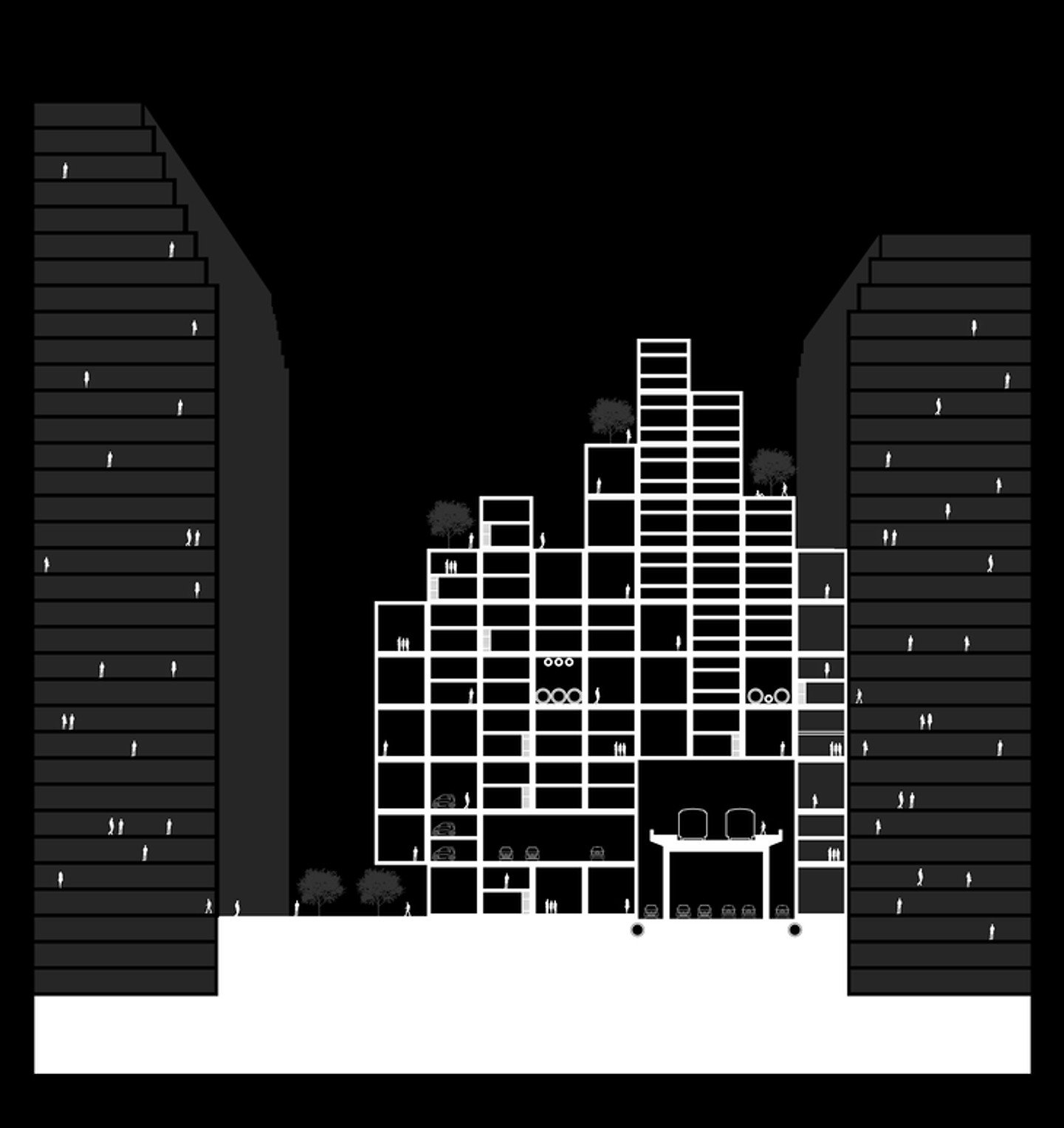


Climate Change
The system also perfectly adapts the recent trend of climate change. Climate change, also called global warming, refers to the rise in average surface temperatures on Earth. An overwhelming scientific consensus maintains that climate change is due primarily to the human use of fossil fuels, which releases carbon dioxide and other greenhouse gases into the air. As measured, the sea level is rising at vital speed that many coastal cities are predicted to suffer from flooding, effecting billions of lives. The infrastructure for preventing flooding from happening is usually extremely expensive, and sometimes not quite effective.






Succession
The architectural elements would act like cells splitting, almost like a chain reaction: at first, there would be only limited amount of modules being installed in the city street; later on, more and more people would discover the advantage of owning one of the units, and they would then generate more and more modules as part of the structure; eventually, the structure would stop growing upwards since the communities simply would not allow more residence or commercial space, it would then expand horizontally in radius that takes over the entire city fabric.

Large Developments
The modular system is not only suitable for smaller units, larger developers and contractors are also able to purchase large space for multiple units and substitute them with their own projects, as long as these projects fits in the perimeter of the grid system. Most importantly, they have to follow the structural order, that their transfer of load need to match the existing system. For these larger projects to take place, they have to follow the same rule that they have to gain the approval by the communities. This allows larger projects’ existence become more flexible: a stadium could be on top of many residential communities, a concert hall could be on the bottom of a large park, or a farm could be on top of a bunch of office areas. These larger developments would fit right in the three denominational city fabric.
Elevated City
By elevating the layers of cities, the government would save enormous amount of budget from building large dam or draining system. Plus, most of units in the structure are owned by civilians or private corporations. When the sea level eventually raised over the ground level of these cities, people could just continue to move up on the existing structure. Since the aluminum alloy hake strong resistance against eroding in water, they could stand sturdy in the water. The new waterways throughout the cities would be the new opportunity to develop new water transportation systems. As a whole, these flooded cities would be the permanent monuments to warn the world of the climate change.






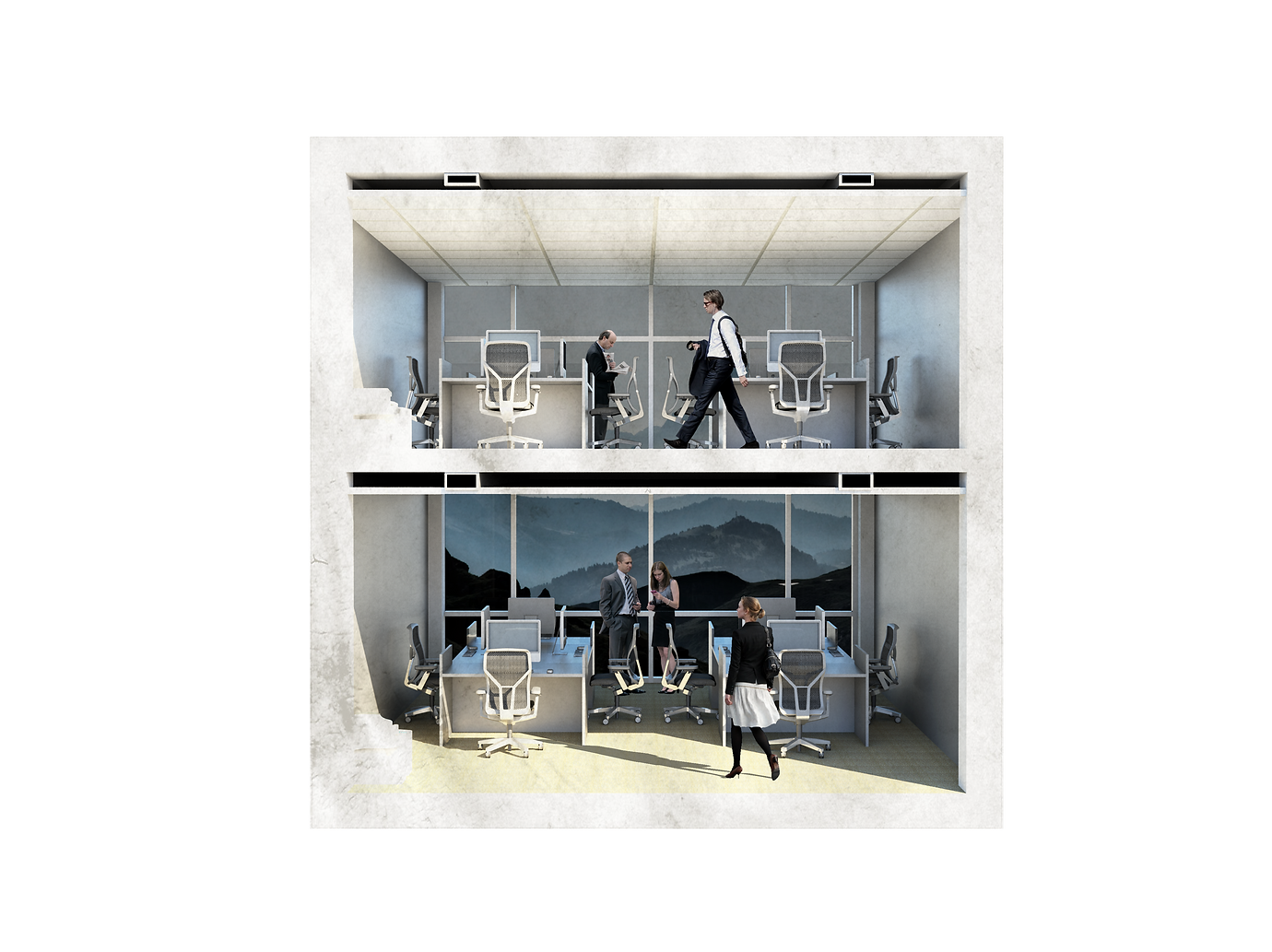
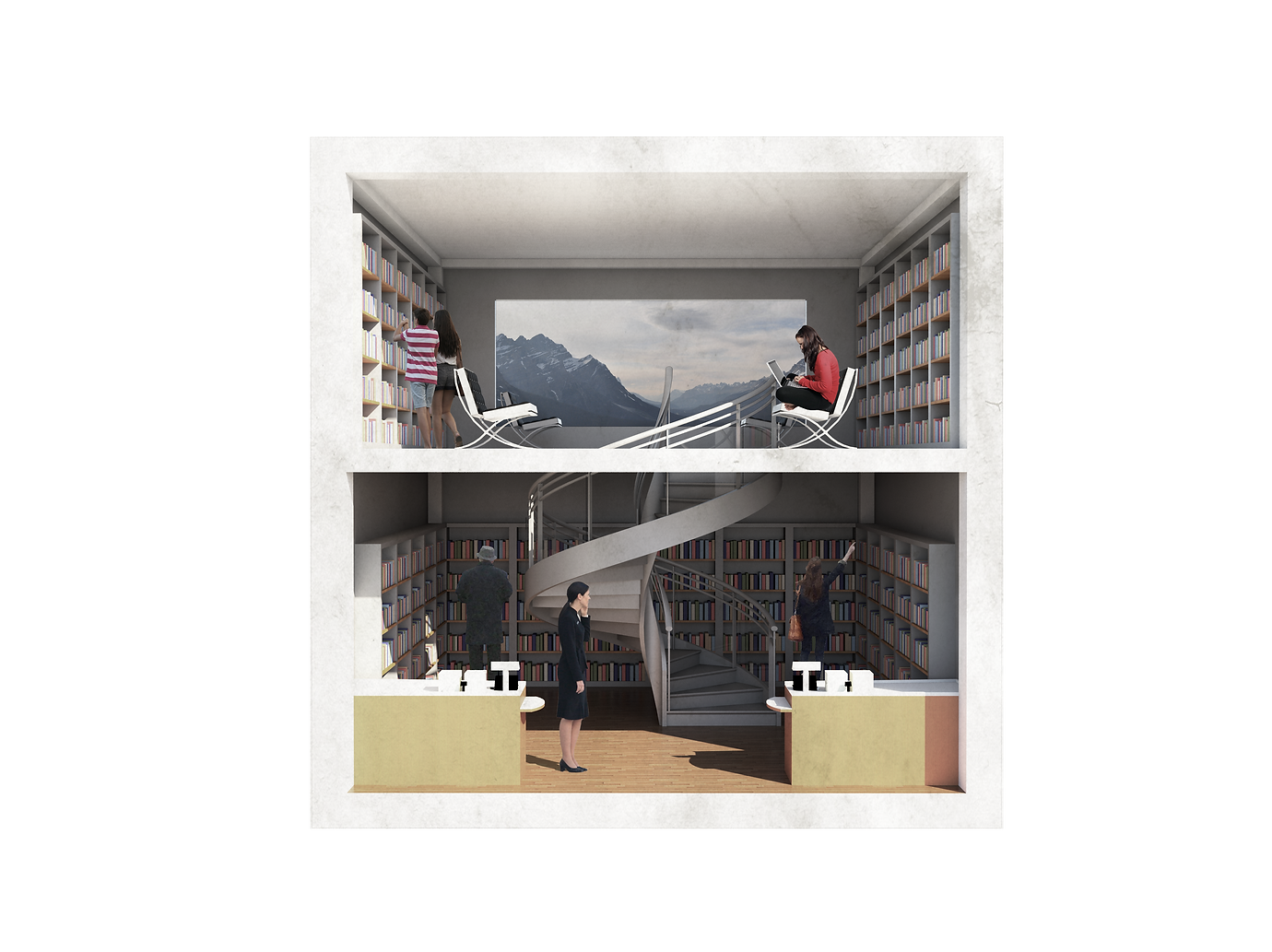
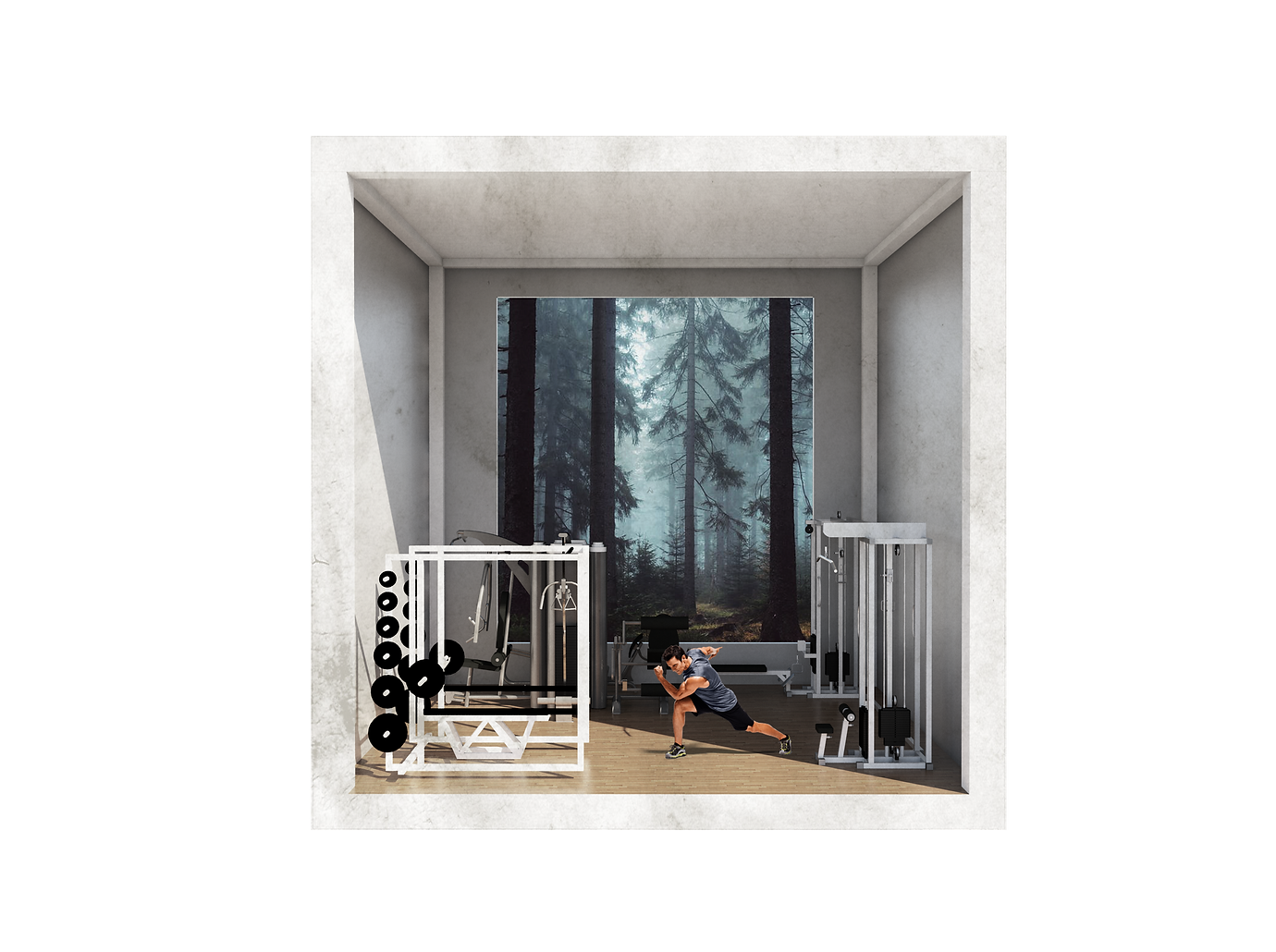
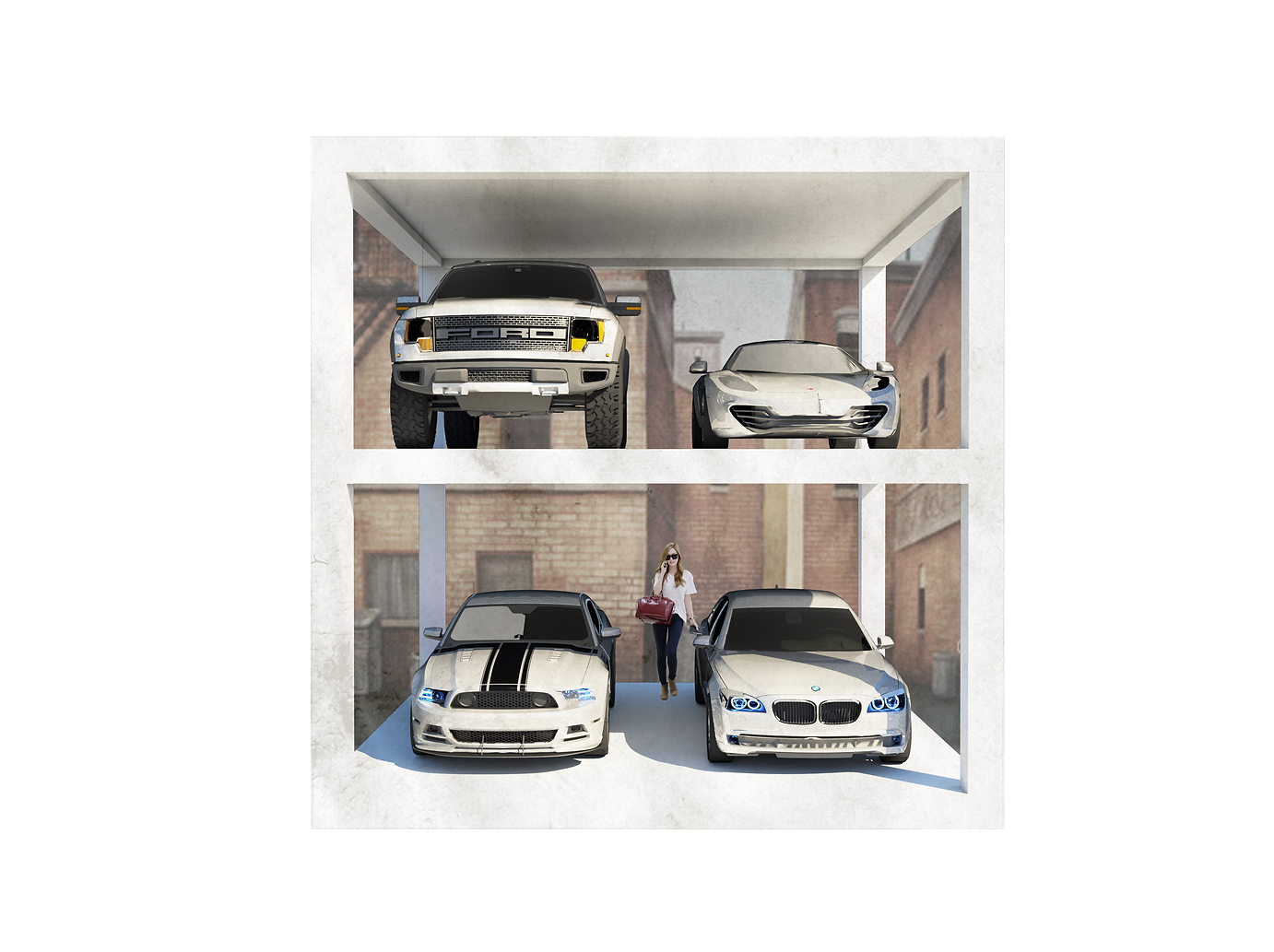



The Exterior Panels
The Garden of Informal Formality is a Tantric wood transferred triptych, that is, a digital fabricated large drawing being transferred on the triptych board. Together, this format is an efficient story telling presentation for both the open source urbanism and the form of informal urban typology.
On the exterior of the triptych, when both panels are at closed position, one large painting appears. The blue-gray grisaille graphic illustrates the formation of the new garden of informal formality.
The center object is a literal representation of the earth, standing for the environment humans are currently inhabiting. Since the center is earth, the dark background would be the outer space. The reason there is no stars is to draw attention of the center, also imply the mysterious nature of the universe. The plane within the sphere can be easily read as the ground level, which contains a story telling graphic about the making process of these frames. Framing outside of this sphere, a white frame stands in a isometric view, which creates a great visual impact composition wise.
The entire composition of this drawing encompasses a paradox, that these frames in the graph are manufactured at a location somewhere on earth. It is also made happen by consuming the resources from the earth. However, these frames will later populate the cities, and become a part of earth. In this process, these frames are actually preventing human from consuming more fossil energy and natural resources. Human will inhabit these frames, and turn them into different programs. At the same time, these frames are inhabiting this planet as well. In the end, these frames will contain life within, which is why the entire earth figure is framed within the larger frame.
The painting contains strong geometric order for a strong visual hierarchy. The actual wooden frame of the painting is a square divided into two half. Then, the dark background brings out the main element, which is a frame in a isometric view, forming a hexagon. Then the earth like sphere perfectly mounts in the hexagon frame. Looking into the sphere, a section of shows the ground. Even though people read this plane as a round flat ground, the shape in the larger composition appears to be an oval within the sphere.

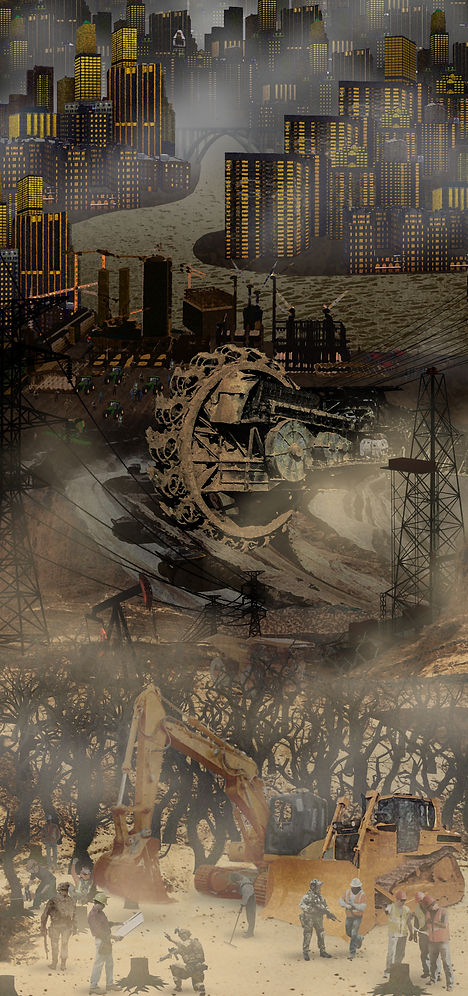

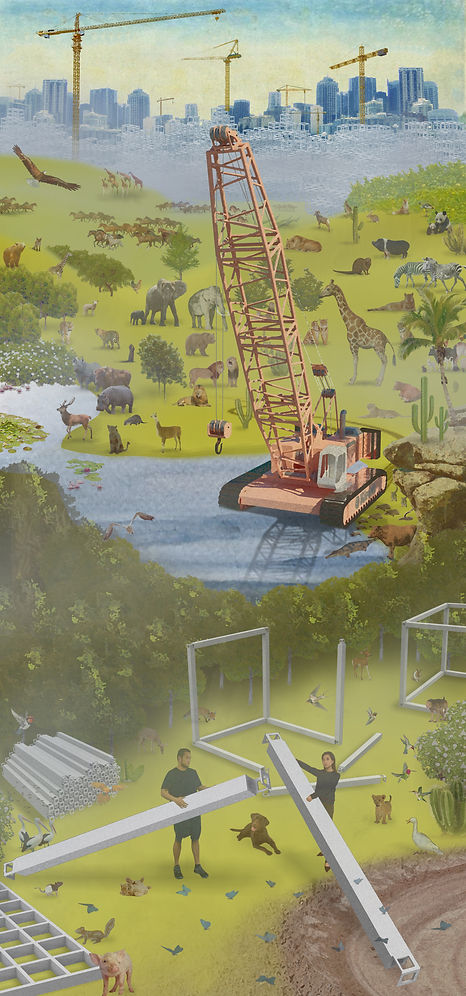
The Left Panel
When the panels are opened from the center between two exterior panels like a typical window opening from outside, tree panels will be presented. These tree panels are the continuation of the exterior panel, as a part of the story telling.
Since the exterior panel features the process of making each module, as well as shipping, in a remote location, the interior panels continues the story in a different location. The left panel illustrates the making of open source cities and the parameters of them. The center panel vividly presents the infinite possibilities of the new urban typology and various activities of people who inhabit it. The right panel proposes an alternative reality where the open source cities were not constructed, and the issues of current world were not realized. Presentation wise, these panels tell a very comprehensive story by themselves.
As said, the left panel is a illustration of a new city in making. The picture is taken at the parameter of the city, showing the exciting moments of parts that come together, as well as the city undergoing its density expansion.
Due to the size of this painting, it is divided into three parts: the foreground, the middleground, and the background. The foreground is showing how the parts coming together as a individual module. The middleground illustrates the possibility of lush life on the parameter of cities. The the background is the newly built city it self, the city of promise in making.
The overall landscape of this panel is heavily vegetated. Lots of natural elements are presented in it. Except for two main characters in the foreground, this panel does not contain another human figure. Instead, hundreds of animals are placed everywhere. In this way, the painting gives the least amount of human environmental impact on the parameter of the cities.
The Center Panel
The center panel is the focus of the triptych, and entirely illustrates the activities inside of the city. This panel also is divided into the foreground, the middleground, and the background as a story telling representation.
The foreground can be viewed as an architecture section, which examines the technical aspect of this modular system. With water, electricity, air circulation systems , and structural members shown in the section, the proposal appears to be more convincing.
The foreground also illustrates individual lives within a very close range, as well as very different building programs and various lifestyles. The multi-layer nature of this new intervention can be seen in the foreground as well.
The middleground shows a collective picture of how people could interact with this system. Hundreds of individuals doing very different activities in this graphic represents for the rising of the new individualism.
Also, it proposes the separation of traffic and pedestrian, which enables people to inhabit any place they want instead of being constantly terrified by the city traffic. With many layers of traffic, the city operates much more efficient and more convenient for average citizens.
The background is more of a impression, which show what cities could look like. With the old buildings almost looking like monuments, new modules could grow on them, and even become a part of them.
Although these renderings are convincing, the fantastical style of this drawing still informs people that this is an imagination of a city. It is more of a polemic project than it is a problem solving architectural or urban planning proposal.
s the dawn in the background, represents for the promise and hope for the bright future soon follows.
The Right Panel
Since the traditional triptych usually gives meaning to the divine of holy trinity, which is western art that represents the intersection of divine energy with earthly life. In the painting The Garden of Earthly Delights, dutch painter Hieronymus Bosch painted three scenes of the inner triptych not necessarily intended to be read chronologically from left to right.
The left panel of The Garden of Earthly Delights depicts God presenting Eve to Adam, the central panel is a broad panorama of socially engaged nude figures, fantastical animals, oversized fruit and hybrid stone formations. The right panel is a hellscape and portrays the torments of damnation.
Responding to Hieronymus Bosch’s painting, the right panel of The Garden of Informal Formality is an illustration of destruction.
This panel is an imaginary future of humanity where the issues of current society are not realized and paid attention. With the speed of urban growth, many forests and natural habitat for various species will no long exist. The ever growing fossil burning will warm up the atmosphere and cause more serious problem instead of just air pollution. Plus, the increasing population will consume more and more natural resources, bring the planet to a doom.
On this panel, there is the same mist through out the entire painting. Contradicting to the morning mist on the left panel, this represents the pollution brought by fossil burning and resource digging, which are more of a toxic air.
This is obviously an exaggeration of what could happen. However, this also seems to be the better way to draw attention of the existing serious problems. In this way, the right panel successfully creates a better contrast with the left panel and the center panel.





